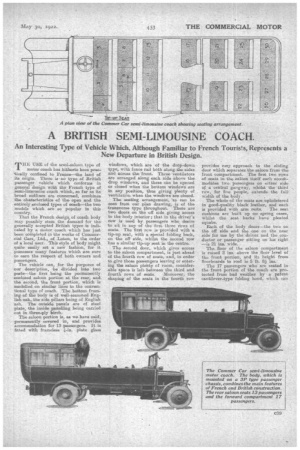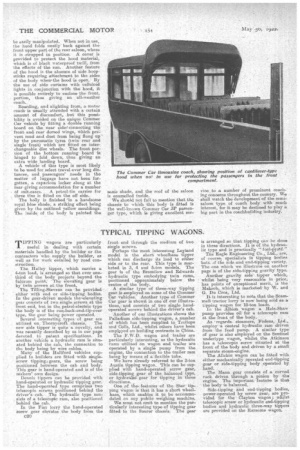A BRITISH SEMI-LIMOUSINE COACH.
Page 13

Page 14

If you've noticed an error in this article please click here to report it so we can fix it.
An Interesting Type of Vehicle Which, Although Familiar to French Tourists, Represents a New Departure in British Design.
T" USE of the semi-saloon type of motor coach has hitherto been peso-tioally confined to France—the land of its origin. There is 'no type of British passenger vehicle which conforms in general design with the French type of semi-limousine coach which, so far as its broad outlines are concerned, combines the characteristics of the open and, the entirely enclosed types of coach—the two models which are so popular in this country. body may the French design, of coach may possibly stem the demand for the generally accepted British types is indicated by a motor coach which has just
pl in pl in
been completed the works of Commercial Cars, Ltd., of Luton, to the order of a local user. This style of body might quite easily set a new fashion, for it possesses many featur sure to which are to earn the respect of both owners and passengers_ The vehicle can, for the purposes of our description, be divided lute two parts—the first being the permanently enclosed saloon portion at the rear, and the second, the front portion, which is modelled on similar lines to the conventional type of coach. The bottom training of talc body is of well-seasoned English oak, the side pillars being of English eh The outside panels are of steel plate, the inside panelling being carried out in throe-ply birch. The saloon 'portion is, BA we have said, permanently covered in, and provides accommodation for 13 passengers. It is fitted with frameless 1-in, plate glass windows, which are of the drop-down type, with fence rail both along-the sides and across the front. Three ventilators arc arranged along each side above the drop windows, and these can be opened or closed when the bottom windows are in any position, thus giving plenty of ventilation when the windows are closed. The seating arrangement, as can be seen from our plan drawing, is of the transverse type throughout. There ar6 two doors on the off side giving access to the hotly interior; that in the driver's row is used by passengers who desire to sit in any of the first three rows of seats. The first row is provided with a tip-up seat, with a special folding back, on the off side, whilst the second row has a similar tip-up seat in the centre.
The second door, which gives access to the saloon compartment, is just. ahead of the fourth row of seats, and, in order to give those passengers leaving or entering the saloon plenty of room, considerable space is left between the third and fourth rows of seats. Moreover, the shaping of the seats in the fourth row provides easy approach to the sliding door which separates-the saloon from-the front compartment. The first two rows of seats in the saloon itself each aceorhmodates two passengers on either side of a central gangway, whilst the third TOW, for five people, extends the full' width of the body. The whole of the seats are, upholstered in good-quality black leather, and each is provided with arm rests. The seat cushions are built up on spring cases, whilst the seat backs have pleated squabs. Each of the body doors—the two on off the 'o side and the one on the near side for use by the driver and the conductor or passenger sitting on his right --is 21 ins, wide. rt The floor of the saloon compartment is raised 2 ins, above the floor level of the front portion, and its height from floorboards to roof is who 5-11. ins. The 17 passengers are seated in
the fro ea
nt portion of the coach are protected from bad weather by a patent cantilever-type folding hood, which can
be easily manipulated. When not in use, the heod folds neatly back against the front upper part of the rear saloon, where it is :strapped in position. A cover is provided to protect the hood material, which is of black waterproof twill, from the effects of' the sun. Another feature of the hood is the absence of side hoop. sticks requiring attachment to the sides of the body whensthe hood is open. By the use of side curtains with celluloid lights in conjunction with the hood, it is possible entirely to enclose the front, portion, thus giving an all-weather coach.
Boarding, and alighting from, a motor coach is usually attended with a certain amount of discomfort, but this possibility is avoided on the unique Commer Car vehicle by fitting a double running board on the near side?connecting the front and rear domed wings, which pre-: vent mud and dust from being flung up by the pneumatic tyres (twin rear and single front) which are fitted on interchangeable disc wheels. The front portion of the bottom running board is hinged to fold down, thus giving an extra wide landing board. A vehicle' of this type is most likely to be used for select travel over long distances, and passengers' needs in the matter of luggage have not been forgotten, a capacious locker slung at the rear giving accommodation for a number of snit-cases. A petrol-tin carrier for three tins is fitted on the off side.
The beffy is finished in a handsome royal blue shade, a striking effect being given by the outlined yellow mouldings. The inside of the body is painted the same shade, and the roof of the saloon is enamelled inside.
We should not fail to mention that the chassis to which this body is fitted is the well-known Commer Car 3P passenger type, which is giving excellent eer
vice to a number of prominent coaching concerns throughout the country. We shall watch the development of the semisaloon type of coach body with much interest, for it may be destined to play a big part in the ceachbuilding industry.












































